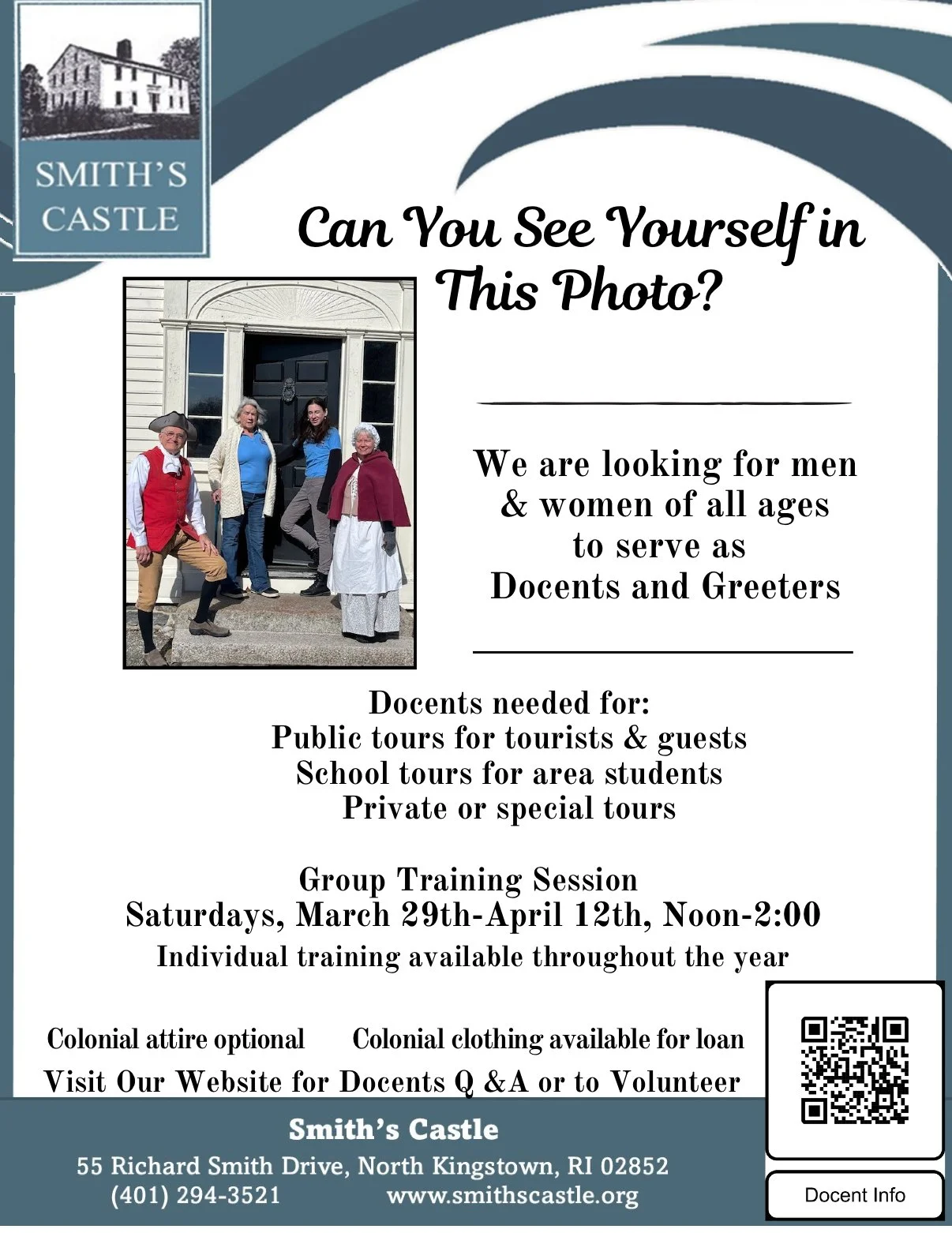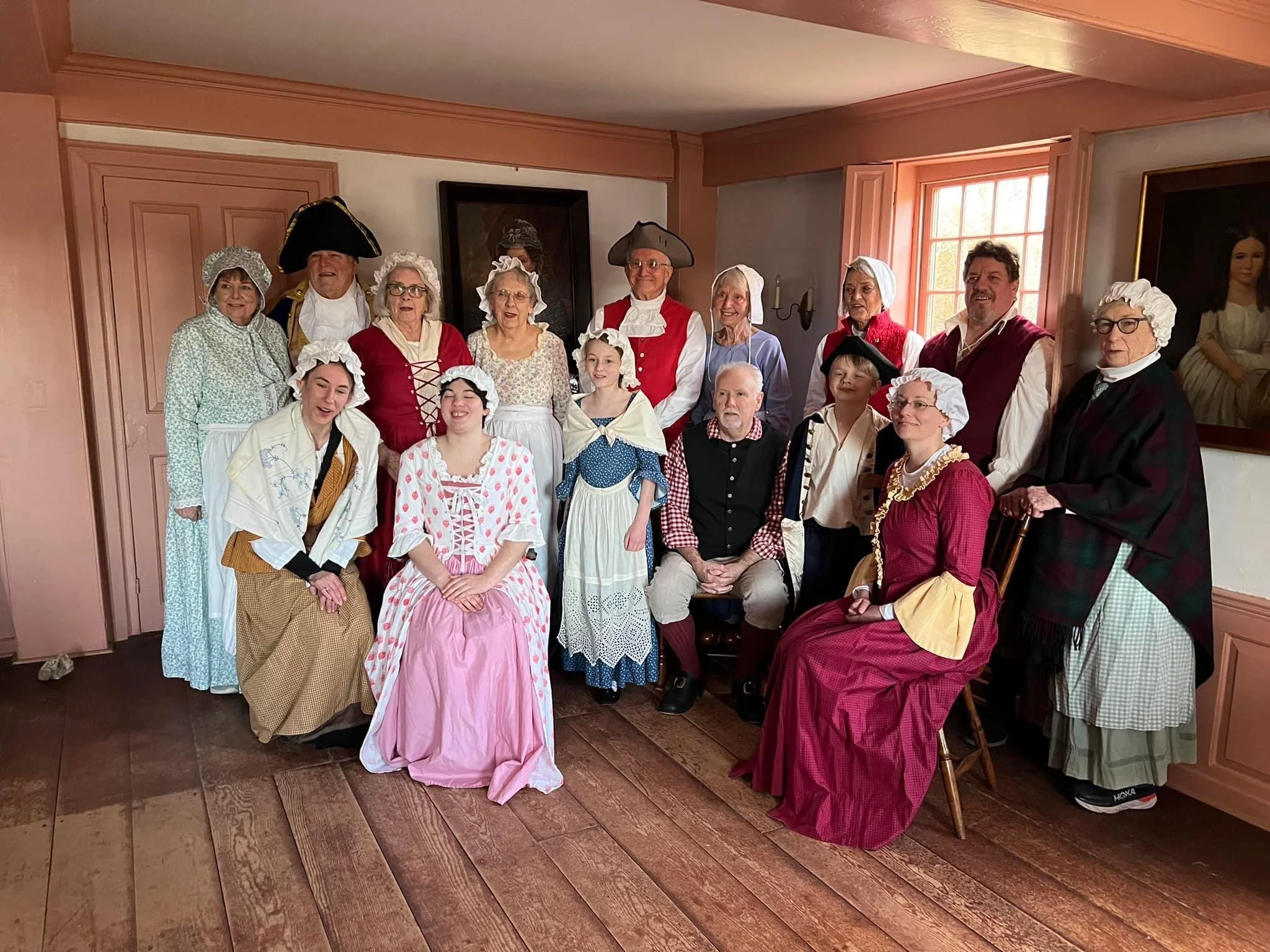LOVE LOCAL HISTORY? consider becoming a docent or greeter
For over 70 years, dedicated volunteers at North Kingstown’s Smith’s Castle have been inspiring visitors from throughout the world and local school children with tales of our earliest Rhode Island history. Docents in colonial attire interpret Castle history through 50-minute tours of the two-story 1678 house from May through mid-October. Greeters provide an important first contact with the public, staffing the Visitors’ Center to welcome guests and collect admission fees.
For further information please contact Smith’s Castle at (401) 294-3521 or by email at smithscastle55@gmail.com. Smith's Castle, 55 Richard Smith Dr., North Kingstown is a Non-Profit 501(c)3 National Historical Site.
2025 Training begins Saturday March 29th 12-2pm, with two more sessions the following two Saturdays April 5th & 12th (12-2). Colonial attire is now optional. Individual training is available throughout the year.
If you wish to volunteer in other ways for Smith’s Castle please visit our Volunteers page Here
Q & A for Prospective Docents & Greeters
Q. When are training docent sessions held?
A. A four week group training session is held in April; however, it is possible to arrange for one-on-one training or to do training on-line during other times of the year. The training covers procedures at the Castle as well as providing extensive historical background which you will find helpful in interpreting our historic house.
Q. What does a docent do?
A. A docent gives guided tours of the Castle, telling our visitors about its history and the people who once lived there.
Q. How will I know what to say?
A. The four-week training sessions will give you the background information you need. In addition, a provided manual gives detailed material for each room of the Castle as well as its former inhabitants. The manual also has a script for a sample tour and cue cards for each room.
After the four-week training, you will “shadow” an experienced docent until such time as you feel confident to give tours on your own.
Docents work shifts in pairs so there will always be another docent to help out as needed.
Q. Will I have to memorize all that material?
A. No. Far more material is provided than you could possibly use. Docents typically pick out the factual information in which they are most interested themselves because that enthusiasm is catching. For that reason, every docent does a tour a little differently and you will find that you will probably vary your own presentation from time to time depending on your audience.
Also, don’t worry too much about memorizing specific dates; guests usually do not find those particularly interesting.
Q. What if I make a mistake or don’t know the answer to a question?
A. Even experienced docents don’t know all the answers and you’re not expected to either. Usually, I say something like, “That’s a really good question. I’ll have to look that up.” Or “Good question; what do you think?” or “When we finish the tour, let’s ask the other docent; he/she might be able to answer that question.”
Q. How long are the tours?
A. Tours typically last about 50 minutes. The size of a tour group will vary from about 2-6. Occasionally there may be larger groups but you may even give a one-on-one tour.
Q. How much of my time will being a docent take?
A. Docents are asked to sign up for two 4-hour shifts a month. You will pick the dates. Interpretive tours of the house are typically offered at: noon, 1:00, 2:00, and 3:00 p.m.
Saturday and Sunday in May, September and until mid-October
Friday, Saturday and Sunday in June, July and August.
Docents are asked to be there by 11:45 to help open up and to stay a few minutes at the end to close up.
Docents are also requested to attend a Docent Meeting on the first Saturday of each month at 9:30 am.
If you volunteer for School Programs or for Special Groups coming in, you might occasionally spend another 1-2 hours for those tours, but this is optional.
Finally, there are four public events during the year during which docents typically volunteer to give tours or to serve in some other capacity.
Q. Do I have to dress up in colonial attire when I’m giving a tour?
A. We would prefer that you do so; however, we are flexible if there are specific circumstances which preclude it. Our guests expect it, and it adds a great deal to their experience. We do have a limited number of clothing articles available in various sizes; these may be borrowed if needed. Some docents prefer to make their own and we have patterns available.
In extremely hot weather, modifications can be made; however, we try not to cancel tours.
Q. What questions might I ask myself to determine if being a docent at Smith’s Castle is something I would like to do at this time?
A. Would I like to learn more about early Rhode Island history? Would I like to share my interests with other people? Do I enjoy meeting new people? Am I looking for a meaningful volunteer activity? Do I have a few hours a month to spend at the Castle?
Q. What is a greeter and what do they do?
A. Our greeters are also very important to the Castle. They are the Castle’s first contact with our guests, welcoming them with a smile, giving tour information, answering general questions and taking admission fees. This is a wonderful volunteer opportunity for someone who does not feel comfortable with actually leading tours or with limited mobility. Greeters follow the same schedules as docents and usually wear colonial attire.
Q. I’d really like to speak to someone personally to ask some questions that have not be covered. Is it possible to do that?
A. Certainly. Either call the Castle Office at (401) 294-3521 or email us at smithscastle55@gmail.com.
Our office hours are limited, but please leave your name, phone number and email address, and someone will contact you.
Q. How do I sign up for the training sessions?
A. Please fill out and submit the Docent/Greeter Form below.
Docent/Greeter form
Some our docents and junior docents!

